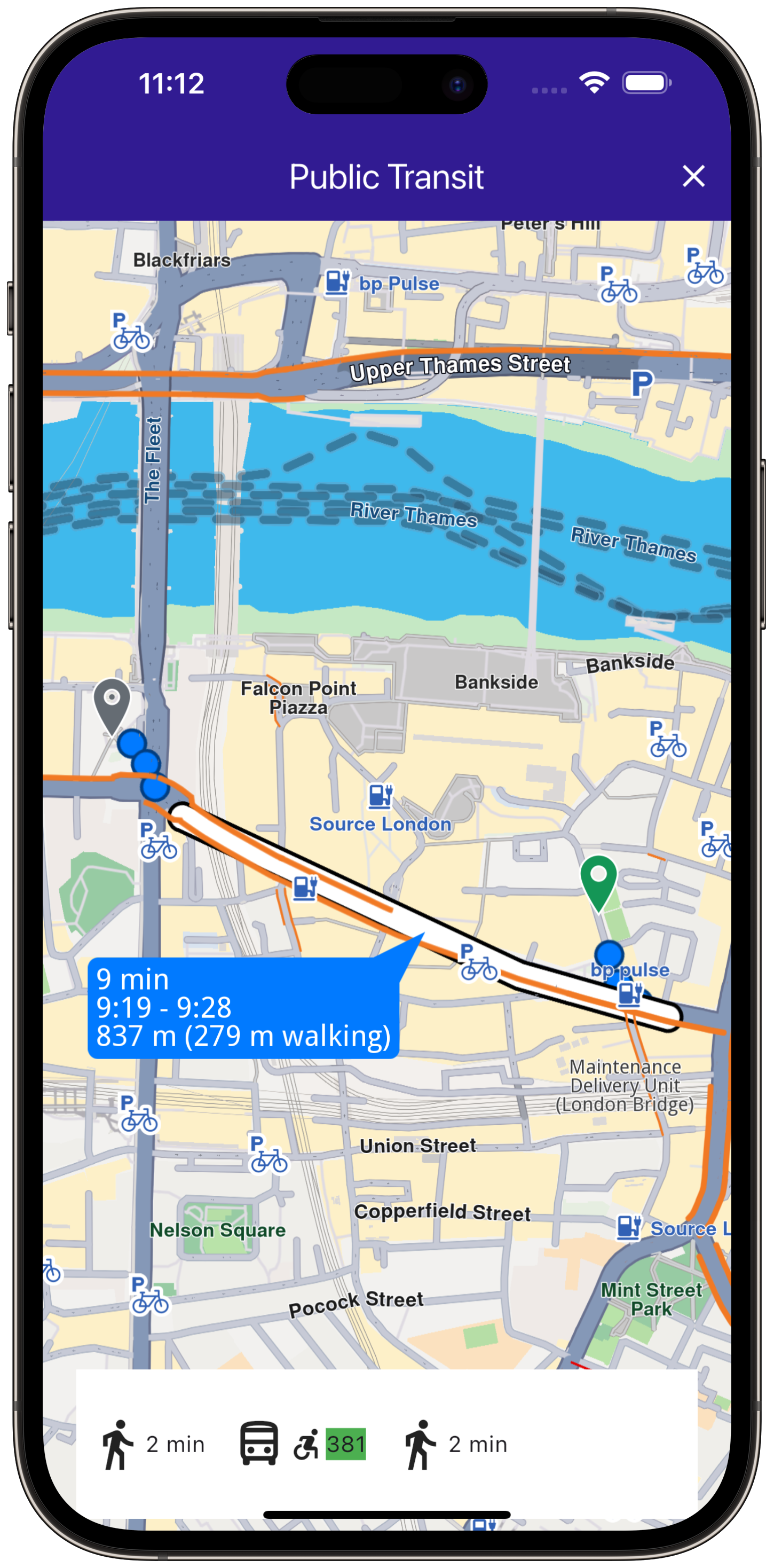Public Transit¶
gem_kit package.
|
Setup¶
Prerequisites¶
Build and Run¶
Navigate to the project folder for this example to build and run the application.
Note - the gem_kit directory containing the Maps SDK for Flutter
should be in the plugins directory of the example, e.g.
example_pathname/plugins/gem_kit - see the environment setup guide above.
Run: flutter pub get
Configure the native parts:
First, verify that the ANDROID_SDK_ROOT environment variable
is set to the root path of your android SDK.
In android/build.gradle add the maven block as shown,
within the allprojects block, for both debug and release builds:
allprojects {
repositories {
google()
mavenCentral()
maven {
url "${rootDir}/../plugins/gem_kit/android/build"
}
}
}
in android/app/build.gradle
within the android block, in the defaultConfig block,
the android SDK version minSdk must be set as shown below.
Additionally, for release builds, in android/app/build.gradle,
within the android block, add the buildTypes block as shown:
Replace example_pathname with the actual project pathname
android {
defaultConfig {
applicationId "com.magiclane.gem_kit.examples.example_pathname"
minSdk 21
targetSdk flutter.targetSdk
versionCode flutterVersionCode.toInteger()
versionName flutterVersionName
}
buildTypes {
release {
minifyEnabled false
shrinkResources false
// TODO: Add your own signing config for the release build.
// Signing with the debug keys for now, so `flutter run --release` works.
signingConfig signingConfigs.debug
}
}
}
Then run the project:
flutter run --debugorflutter run --release
App entry and initialization¶
const projectApiToken = String.fromEnvironment('GEM_TOKEN');
void main() {
runApp(const MyApp());
}
This code initializes the projectApiToken with the required authorization token and launches the app.
How It Works¶
Main App Setup: The main app initializes GemKit and displays a map.Route Calculation: Users can tap a button to calculate a route between two predefined landmarks.Route Visualization: The calculated route is displayed on the map, along with transit segments at the bottom of the screen.
User Interface¶
class MyApp extends StatelessWidget {
const MyApp({super.key});
@override
Widget build(BuildContext context) {
return const MaterialApp(
debugShowCheckedModeBanner: false,
title: 'Public Transit',
home: MyHomePage(),
);
}
}
class MyHomePage extends StatefulWidget {
const MyHomePage({super.key});
@override
State<MyHomePage> createState() => _MyHomePageState();
}
Main Screen with Transit Routes¶
class _MyHomePageState extends State<MyHomePage> {
late GemMapController _mapController;
TaskHandler? _routingHandler;
List<PTRouteSegment>? _ptSegments;
@override
void dispose() {
GemKit.release();
super.dispose();
}
@override
Widget build(BuildContext context) {
return Scaffold(
appBar: AppBar(
backgroundColor: Colors.deepPurple[900],
title: const Text('Public Transit', style: TextStyle(color: Colors.white)),
actions: [
if (_routingHandler == null && _ptSegments == null)
IconButton(
onPressed: () => _onBuildRouteButtonPressed(context),
icon: const Icon(Icons.route, color: Colors.white),
),
if (_routingHandler != null)
IconButton(
onPressed: () => _onCancelRouteButtonPressed(),
icon: const Icon(Icons.stop, color: Colors.white),
),
if (_ptSegments != null)
IconButton(
onPressed: () => _onClearRoutesButtonPressed(),
icon: const Icon(Icons.clear, color: Colors.white),
),
],
),
body: Stack(alignment: AlignmentDirectional.bottomCenter, children: [
GemMap(onMapCreated: _onMapCreated, appAuthorization: projectApiToken),
if (_ptSegments != null)
Padding(
padding: const EdgeInsets.all(8.0),
child: Container(
height: MediaQuery.of(context).size.height * 0.1,
width: MediaQuery.of(context).size.width * 0.9,
color: Colors.white,
child: Row(
children: _ptSegments!.map((segment) {
return TransitSegment(segment: segment);
}).toList(),
),
),
),
]),
);
}
void _onMapCreated(GemMapController controller) {
_mapController = controller;
}
// Additional methods for route calculation...
}
This code sets up the main screen with a map and functionality for calculating and displaying public transit routes.
Route Calculation¶
void _onBuildRouteButtonPressed(BuildContext context) {
final departureLandmark = Landmark.withLatLng(latitude: 51.505929, longitude: -0.097579);
final destinationLandmark = Landmark.withLatLng(latitude: 51.507616, longitude: -0.105036);
final routePreferences = RoutePreferences(transportMode: RouteTransportMode.public);
_showSnackBar(context, message: "The route is being calculated.");
_routingHandler = RoutingService.calculateRoute([departureLandmark, destinationLandmark], routePreferences, (err, routes) {
_routingHandler = null;
ScaffoldMessenger.of(context).clearSnackBars();
if (err == GemError.success) {
final routesMap = _mapController.preferences.routes;
routesMap.add(routes!.first, true, label: routes.first.getMapLabel());
_mapController.centerOnRoutes(routes: routes);
final ptRoute = routes.first.toPTRoute();
final ptSegments = ptRoute!.segments.map((seg) => seg.toPTRouteSegment()).toList();
setState(() {
_ptSegments = ptSegments;
});
}
});
setState(() {});
}
This code handles the route calculation and updates the UI with the calculated segments.
Transit Segment Display¶
class TransitSegment extends StatelessWidget {
final PTRouteSegment segment;
const TransitSegment({super.key, required this.segment});
@override
Widget build(BuildContext context) {
return Padding(
padding: const EdgeInsets.symmetric(horizontal: 8.0),
child: segment.transitType == TransitType.walk
? Row(
children: [
const Icon(Icons.directions_walk, size: 35.0),
Text(convertDuration(segment.timeDistance.totalDistanceM)),
],
)
: Row(
children: [
const Icon(Icons.directions_bus_outlined, size: 35.0),
if (segment.hasWheelchairSupport) const Icon(Icons.accessible_forward),
Container(color: Colors.green, child: Text(segment.shortName)),
],
),
);
}
}
This widget displays transit segments and relevant information about each route leg.
Utility Functions¶
String convertDistance(int meters) {
if (meters >= 1000) {
double kilometers = meters / 1000;
return '${kilometers.toStringAsFixed(1)} km';
} else {
return '${meters.toString()} m';
}
}
String convertDuration(int seconds) {
int hours = seconds ~/ 3600;
int minutes = (seconds % 3600) ~/ 60;
String hoursText = (hours > 0) ? '$hours h ' : '';
String minutesText = '$minutes min';
return hoursText + minutesText;
}
These utility functions convert distances and durations into user-friendly formats.


